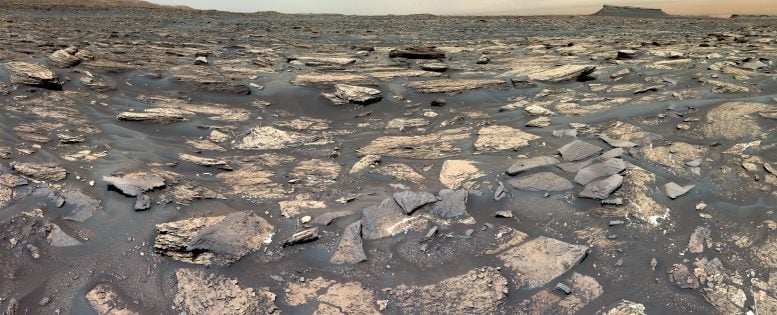
NASA’s Curiosity rover is still searching for signs that the conditions in Mars’ Gale Crater could have supported tiny forms of life. Credit: NASA/JPL-Caltech/MSSS
NASA’s Curiosity rover discovered sandstones rich in manganese, indicating that the Gale Crater on Mars once had conditions suitable for life.
A team of researchers using the ChemCam tool onboard NASA’s Curiosity rover detected higher-than-normal levels of manganese in rocks from the bottom of a lake within Gale Crater on Mars, suggesting that the sediments were formed in a river, delta, or near the edge of an old lake. The findings were published on May 1 in the Journal of Geophysical Research: Planets.
Patrick Gasda, a lead author on the study and part of the Space Science and Applications group at Los Alamos National Laboratory, stated,“It is hard for manganese oxide to form on Mars' surface, so we didn’t expect to find it in such high amounts in a deposit near the shore. On Earth, these deposits are common due to the high oxygen in our atmosphere from photosynthetic life, and from microbes that help trigger these manganese oxidation reactions.
Puzzles of Martian Oxidation
“We don’t have evidence of life on Mars, and we're not sure how oxygen was produced in Mars’s ancient atmosphere, so how the manganese oxide formed and concentrated here is really confusing. These findings suggest larger processes happening in the Martian atmosphere or surface water, and indicate that more research is needed to understand oxidation on Mars,” added Gasda.
ChemCam, created at Los Alamos and CNES (the French space agency), uses a laser to create a plasma on a rock's surface and captures the light to measure the elements in rocks.
Insights into Sedimentation
The rocks explored by the rover are a mixture of sands, silts, and muds. The sandy rocks are more porous, allowing groundwater to pass through more easily compared to the muds that make up most of the lakebed rocks in the Gale Crater. The research team examined how manganese may have been concentrated in these sands—for instance, by groundwater moving through the sands on the lake's edge or at the mouth of a delta—and what substance could have caused manganese to form in the rocks.
On Earth, manganese becomes concentrated due to oxygen in the atmosphere, often accelerated by the presence of microbes. Microbes on Earth can use the various oxidation states of manganese as energy for metabolism; if life existed on ancient Mars, the increased amounts of manganese in these rocks on the lake shore would have been a helpful energy source for life.
Comparing Mars and Earth
“The environment of the Gale Lake, as revealed by these ancient rocks, offers insight into a habitable environment that resembles places on Earth today,” stated Nina Lanza, principal investigator for the ChemCam tool. “Manganese minerals are common in the shallow, oxygenated waters found on lake shores on Earth, and it’s remarkable to find such recognizable features on ancient Mars.”
Reference: “Manganese-Rich Sandstones as an Indicator of Ancient Oxic Lake Water Conditions in Gale Crater, Mars” by P. J. Gasda, N. L. Lanza, P.-Y. Meslin, S. N. Lamm, A. Cousin, R. Anderson, O. Forni, E. Swanner, J. L’Haridon, J. Frydenvang, N. Thomas, S. Gwizd, N. Stein, W. W. Fischer, J. Hurowitz, D. Sumner, F. Rivera-Hernández, L. Crossey, A. Ollila, A. Essunfeld, H. E. Newsom, B. Clark, R. C. Wiens, O. Gasnault, S. M. Clegg, S. Maurice, D. Delapp and A. Reyes-Newell, 1 May 2024, Journal of Geophysical Research: Planets.
DOI: 10.1029/2023JE007923
Funding: NASA Jet Propulsion Laboratory



